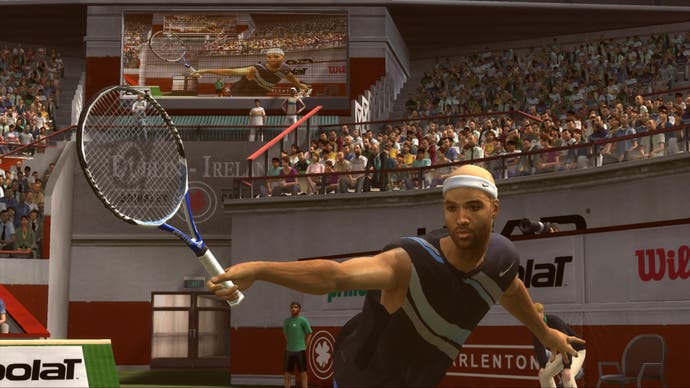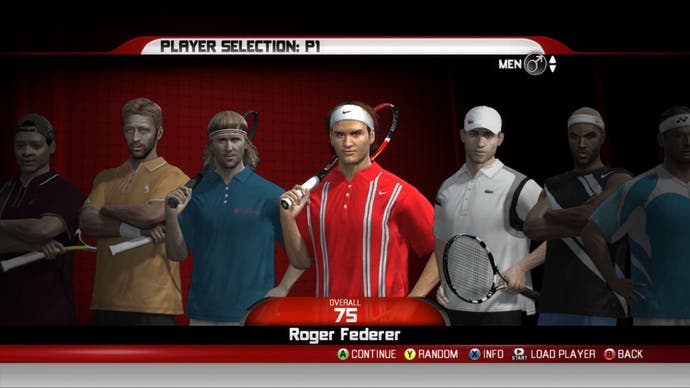Top Spin 3
Love at first service.
As you might expect, self-improvement follows the fairly standard process of allocating your XP in eight different areas (Forehand, Backhand, Service, Return, Volley, Power, Speed, Stamina). With each set by default at level 30, it's then entirely your choice how you evolve your player. However, with the overall level of your player capped at 560 out of a maximum of 800, you can't max out every stat like you can in other tennis titles. This essentially forces you to prioritise specialist areas of your game; for example, a powerful service, possibly at the expense of stamina, or a nippy net player with sublime volley skills. It's an interesting design choice, and definitely helps shape the way you play the game both offline and online. The only real downside to the Player Evolution is PAM's insistence of playing Jamiroquai's godforsaken "Canned Heat" track every single time you enter the upgrade screen. Still, with The Go! Team and The Stone Roses bouncing and shuffling their way through the other in-game menus, it's not all bad.
Ploughing on beyond the rather straightforward Junior mode brings the reward of Pro status. At this point, the game really starts to come into its own, not just in terms of upping the ante challenge-wise, but having the added allure of letting you play the real-life tennis elite, which in this case means the likes of Roger Federer, Andy Murray, Andy Roddick and Tommy Haas on the male side, and the stupidly well put-together Maria Sharapova for the women's game. From my own thumb-bruising experience, it's brutally challenging to play the hard tournaments in Pro until you've ranked up a fair bit. At this point, you've got a few other useful means of making serious progress: either take the lesser rewards of the easy tournaments, slope off to play the game's standalone tournaments outside of career mode, or try your luck in the online World Tour mode. Whichever you choose, they all help get you the extra XP you need to outperform the better players, and you can eventually return to claim the Pro title and unlock the super-elite Legends mode if you're super-committed.

Inevitably, the further you progress into the game, the lengthier matches become, and the more of an investment of time and energy is required to get through the seasons. In a game where five rounds of a single tournament can easily eat up the best part of an hour, it's not difficult to see what a time-sink Top Spin 3 can be once it gets going. As such, the realisation of the intense demands of career mode makes the online play that much more attractive, and it's possibly here where the game is at its best. Presented with the choice of a quick single three-set, first-to-three game or a more expansive array of tournaments, you're well catered for. World Tour seasons are effectively set over a number of real-time weeks, with the winners based around overall performance during that time. Impressively, the game is very lag-tolerant (unlike VT3, which was a write off most of the time), and although I did experience a few slight glitches here and there, at no stage did it feel like the game was being compromised in any serious way. As far as online tennis goes, Top Spin 3 is top dog, although annoyingly doesn't appear to allow you to set up a custom doubles match.
Another somewhat inexplicable decision PAM has made for this otherwise high-quality sequel is to abandon the more fun training missions you could engage in previously. It's perhaps understandable that the game's creators wanted to streamline the gameplay to be purely about tennis tournaments, but stripping them out inevitably reduces the experience to a one-note succession of matches with no respite or variety along the way. It's not a deal-breaker by any means, but its loss is felt nevertheless. The bizarrely taxing Top Spin school, while necessary, doesn't make up for it at all.

Elsewhere, the game is a uniformly impressive technical tour-de-force, and benefits from an array of subtle improvements that add greatly to the sense of immersion. As well as some glorious animation, little touches like the changing lighting conditions, and the developing sweat patches on players' shirts is a fantastic addition. On that note, it's the first tennis title we can recall where player stamina truly has a palpable effect on how your player performs. A little heart monitor gives you an obvious clue as to when players are really worn out, but it's even better to see a player struggling around the court during a lengthy rally. A lot of these smaller touches aren't necessarily noticeable during the first few hours of play, but once you really start getting into manic tie-break scenarios and endless see-sawing break point recoveries, the epic depth of Top Spin 3 becomes truly apparent. As someone who has earned the game's infamous 2K award, I speak from bitter, hand-ruining experience.
But what you really want to know is whether it's worth buying. Unlike last time out, you'll easily be able to pick this game up today for under GBP 30, making it a must-buy for anyone looking for the most advanced tennis title around. Yes, the often exhausting depth might prove to be off-putting for those who prefer the more intuitive Virtua Tennis, but that's precisely part of Top Spin 3's more simulation-minded appeal. With fantastic online play and an obsessive career mode to dive into, it's the thinking man's tennis title.








